Case Study: Transforming a Pretoria Backyard into a Lush Oasis
The Vision: From Drab to Dreamy
When Jane and Mark first looked at their Pretoria backyard, it was a blank canvas—a patch of tired grass and uninspiring shrubs. They dreamed of a lush oasis where they could relax and entertain guests. The transformation journey began with a clear vision: to create a vibrant, green sanctuary reminiscent of a tropical getaway.
To turn this dream into reality, they enlisted the help of a local landscape design expert who shared their passion for nature and creativity. The designer’s challenge was to maximize the space while incorporating lush greenery, water features, and cozy seating areas.

Planning and Design: Laying the Groundwork
The planning phase was crucial in ensuring every element harmonized with the overall theme. The designer proposed a variety of plants that would thrive in Pretoria’s climate, focusing on texture, color, and height for visual interest. Key features included a koi pond, a pergola with climbing vines, and a meandering stone pathway.
Mark and Jane were heavily involved in the selection process, choosing plants like ferns, bamboo, and bird-of-paradise to evoke a lush, tropical feel. The pathway design was particularly important as it guided visitors through the garden, offering different perspectives and surprises at each turn.
Construction: Bringing the Design to Life
Once the design was finalized, construction began. The transformation required careful coordination between landscapers, builders, and gardeners. One of the first projects was excavating the area for the koi pond, which became the garden's centerpiece. Water features added both visual appeal and a soothing ambiance.

The pergola was constructed next, offering a shaded retreat in the sunny backyard. Climbing plants were strategically placed to grow over the structure, eventually providing a natural canopy. Cozy seating areas with weather-resistant furniture completed the space, ensuring comfort and style.
Planting and Final Touches
Planting was an exciting phase where the backyard began to transform into the lush oasis Jane and Mark had imagined. Native and exotic plants were carefully arranged to create depth and layers. Mulch and decorative stones enhanced the aesthetic while providing practical benefits like moisture retention.

Finishing touches included installing ambient lighting to highlight key features and ensure usability after dark. Solar-powered lights were chosen for their sustainability and soft glow. The couple also added personal touches with garden art and bird feeders to attract local wildlife.
The Result: A Backyard Oasis
The end result was nothing short of breathtaking. The once plain backyard was now a vibrant oasis teeming with life. Jane and Mark were thrilled with their new outdoor space, which quickly became the favorite spot for family gatherings and quiet evenings alike.
This transformation showcases how thoughtful design and strategic planning can turn any outdoor space into a sanctuary. By embracing local flora and sustainable practices, they not only enhanced their property but also contributed positively to their environment.

Conclusion: The Key Takeaways
This case study highlights several important lessons for anyone looking to transform their backyard:
- Start with a clear vision to guide your design process.
- Work with experts who understand your goals and can bring them to life.
- Select plants that are appropriate for your climate to ensure longevity.
- Incorporate personal touches to make the space uniquely yours.
With these principles in mind, anyone can create their own backyard oasis, turning dreams into reality while enjoying the beauty of nature right outside their door.